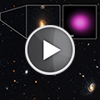CXC Home | Search | Help | Image Use Policy | Latest Images | Privacy | Accessibility | Glossary | Q&A
Tour of XJ1417+52
Quicktime MPEG With closed-captions (at YouTube)
Black holes come in different sizes. The largest, or supermassive, black holes can contain hundreds of thousands times the mass of the Sun up to billions of times its mass and typically reside in the centers of galaxies. Sometimes, however, astronomers find black holes in somewhat unusual places.
Take, for example, the object known as XJ1417+52. First discovered in observations from Chandra and XMM-Newton over a decade ago, this object has some interesting properties. To begin with, astronomers think this object may fall right at the boundary between supermassive black holes and the intermediate-mass category. As their name suggest, the latter class are black holes of medium size in between stellar mass black holes and supermassive ones. X-rays from both Chandra and XMM-Newton show that XJ1417+52 gave off an extraordinary amount of X-rays. This and other pieces of evidence suggest that XJ1417+52 contains about 100,000 times the mass of the Sun.
What makes this object even more interesting is its location. Rather than being in the center of its host galaxy, it is located on its northern edge. Astronomers think this could have happened when a smaller galaxy with XJ1417+52 at its center collided with a larger galaxy. Since these two galaxies are still in the process of merging, the two black holes have yet to coalesce into one bigger black hole, but may do so millions or billions of years from now.
[Runtime: 02:43]
Quicktime MPEG With closed-captions (at YouTube)
Black holes come in different sizes. The largest, or supermassive, black holes can contain hundreds of thousands times the mass of the Sun up to billions of times its mass and typically reside in the centers of galaxies. Sometimes, however, astronomers find black holes in somewhat unusual places.
Take, for example, the object known as XJ1417+52. First discovered in observations from Chandra and XMM-Newton over a decade ago, this object has some interesting properties. To begin with, astronomers think this object may fall right at the boundary between supermassive black holes and the intermediate-mass category. As their name suggest, the latter class are black holes of medium size in between stellar mass black holes and supermassive ones. X-rays from both Chandra and XMM-Newton show that XJ1417+52 gave off an extraordinary amount of X-rays. This and other pieces of evidence suggest that XJ1417+52 contains about 100,000 times the mass of the Sun.
What makes this object even more interesting is its location. Rather than being in the center of its host galaxy, it is located on its northern edge. Astronomers think this could have happened when a smaller galaxy with XJ1417+52 at its center collided with a larger galaxy. Since these two galaxies are still in the process of merging, the two black holes have yet to coalesce into one bigger black hole, but may do so millions or billions of years from now.
[Runtime: 02:43]
(Credit: NASA/CXC/A. Hobart)
Return to XJ1417+52 (October 5, 2016)



